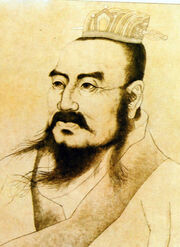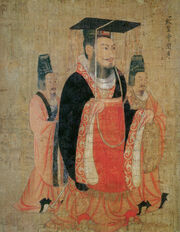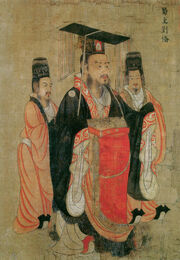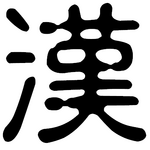The Han (Hàn 漢), or Han dynasty (Hàn cháo 漢朝), was the second imperial dynasty of China. It succeeded the Qin dynasty 秦 in 207 BC and was succeeded by the Three Kingdoms in 220 AD when Cao Pi forced the Emperor Xian to abdicate and make way for Wei.



Brief history[]
The Han dynasty is considered the "Golden Age" or "Golden Dynasty" of China, because it lasted for over four centuries, longer than any other dynasty. It was, however, briefly interrupted by the Xin dynasty 新, founded by Wang Mang 王莽, from 9-23 AD. This interregnum seperates the Han into two periods:
- Western Han (xī Hàn 西漢), also known as Former Han (qián Hàn 前漢).
- Eastern Han (dōng Hàn 東漢), also know as Later Han (hòu Hàn 後漢).
Former Han was founded by the peasant rebel leader Liu Bang 劉邦, posthumously known as Emperor Gaozu of Han (Hàn Gāozǔhuángdì 漢高祖皇帝), in 206 BC.
Later Han was founded by Liu Xiu 劉秀, who became the Emperor Guangwu of Han (Hàn Guāngwǔdì 漢光武帝), in 25 AD.
Wang Mang was killed in 23 AD, and it was actually Liu Xuan 劉玄, alias Emperor Gengshi of Han (Hàn Gēngshǐdì 漢更始帝), who restored the original Han dynasty. Liu Xuan was deposed by Red Eyebrow rebels in 25 AD, and when Liu Xiu came to power he founded a new Han dynasty, now referred to as Later Han.
The Later Han came to an end in 220 AD, when its Emperor Xian was forced to abdicate by Cao Pi, who founded Wei. In 221 AD Liu Bei, who controlled Yi province at that time, founded a kingdom of his own and called it Han, but was called Shu-Han or just Shu by contemporaries who did not acknowledge him the new emperor. In 263 AD Liu Bei's son Liu Shan surrendered Han to Wei.
The name Han 漢[]

During the Qin dynasty 秦朝 Liu Bang was given the title King of Han. In 206 BC, when the last Qin ruler Ying Ziying 贏子嬰 surrendered to Liu Bang the Qin dynasty ended. In 202 BC Liu Bang became Emperor of China. With his title being King of Han, and his state based on the upper Han River, the name of his dynasty was inevitably going to be Han.
On the character han 漢[]
Definitions and other usages:
- A name for a river (the Han River)
- A name for a dynasty (Han Dynasty)
- A Chinese surname
- definition: Chinese people
- definition: Chinese language
- definition: a man
- Traditional: 漢
- Simplified: 汉
- Pinyin with tonemarks: Hàn
- Pronunciation: to add link
The reign colour of Han[]
- Main article: Five Powers
The reign colours of Chinese dynasties were usually in accordance with the theories and phases of the Five Powers (Wǔxíng 五行). If one ruled through Fire, it's conqueror would rule through Water. The "Water-state" would be conquered by one who would rule through Earth. The Han dynasty was a little different. Before Han, there was the Qin dynasty 秦朝, which reigned Black through the Power of Water (because it had conquered the Zhou dynasty 周朝, which reigned Red through Fire). When Qin was defeated in 206 BC and Han was founded one would expect it to reign Yellow through the Power of Earth, but instead it kept ruling through Water.[1] Shortly after the accession of Emperor Wen of Han in 180 BC it was proposed that Han should rule through the Power of Earth (Yellow) instead of Water, because it had conquered Qin as well as various other minor enemies, and the proposal was repeated in 166 BC. Each time the idea was rejected, but eventually it was adopted in 104 BC.[1]
The link between Han and Earth remained unquestionable until the end of the Former Han dynasty. It was now becoming accepted that the Five Powers succeeded each other not by means of conquest, but by way of natural production or creation.[1] Wang Mang 王莽 also accepted this theory and when he seized the throne of Former Han and founded the Xin dynasty 新朝 in 9 AD he picked the Power of Earth, the natural successor of Fire. Some documents which accompanied Wang Mang's accession insisted that the Han dynasty had not enjoyed protection from Earth, as stated above, but from Fire; Red. It's logical successor would thus be Earth and Yellow.[1] From the records that exist today, such as the History of Han (Hàn shū 漢書), no evidence can be found that Former Han ever ruled through the Power of Fire.[2]
When Emperor Guangwu founded Later Han he reaffirmed Red and Fire for his dynasty, as a way to cancel out Wang Mang's usurpation.[1] Until the end of Later Han in 220 AD the dynasty remained Red through the Power of Fire.
List of sovereigns of Han[]
Later Han[]
| Posthumous name | Temple name | Name | Reign | Reign title(s) |
|---|---|---|---|---|
| Emperor Guangwu of Han Hàn Guāngwǔdì 漢光武帝 |
Shizu 世祖 "Epochal Founder" |
Liu Xiu 劉秀 | 25-57 |
|
| Emperor Ming of Han Hàn Míngdì 漢明帝 (full: Xiào Míng huángdì 孝明皇帝) |
Xianzong 顯宗 "Illustrious Exemplar" |
Liu Yang 劉陽 Liu Zhuang 劉莊 |
57-75 |
|
| Emperor Zhang of Han Hàn Zhāngdì 漢章帝 (full: Xiào Zhāng huángdì 孝章皇帝) |
Suzong 肅宗 "Respectful Exemplar" |
Liu Da 劉炟 | 75-88 |
|
| Emperor He of Han | Muzong 穆宗 "Solemn Exemplar" |
Liu Zhao 劉肇 | 88-105 |
|
| Emperor Shang of Han Hàn Shāngdì 漢殤帝 (full: Xiào Shāng huángdì 孝殤皇帝) |
n/a | Liu Long 劉隆 | 105-106 |
|
| Emperor An of Han Hàn Āndì 漢安帝 (full: Xiào Ān huángdì 孝安皇帝) |
Gongzong 恭宗 "Respectful Exemplar" | Liu Hu 劉祜 | 106-125 |
|
| Emperor Shao of Han Hàn Shǎodì 漢少帝 |
n/a | Liu Yi 劉懿 | 125 | |
| Emperor Shun of Han Hàn Shùndì 漢順帝 (full: Xiào Shùn huángdì 孝順皇帝) |
Jingzong 敬宗 "Reverant Exemplar" |
Liu Bao 劉保 | 125-144 |
|
| Emperor Chong of Han Hàn Chōngdì 漢沖帝 (full: Xiào Chōng huángdì 孝衝皇帝) |
n/a | Liu Bing 劉炳 | 144-145 |
|
| Emperor Zhi of Han Hàn Zhìdì 漢質帝 (full: Xiào Zhì huángdì 孝質皇帝) |
n/a | Liu Zuan 劉纘 | 145-146 |
|
| Emperor Huan of Han Hàn Huándì 漢桓帝 (full: Xiào Huán huángdì 孝桓皇帝) |
Weizong 威宗 "Masjestic Exemplar" |
Liu Zhi 劉志 | 146-167 |
|
| Emperor Ling of Han Hàn Língdì 漢靈帝 (full: Xiào Líng huángdì 孝靈皇帝) |
n/a | Liu Hong 劉宏 | 167-189 | |
| Emperor Shao of Han Hàn Shǎodì 漢少帝 |
n/a | Liu Bian 劉辯 | 189 |
|
| Emperor Xian of Han Hàn Xiàndì 漢獻帝 (full: Xiào Xiàn huángdì 孝獻皇帝) |
n/a | Liu Xie 劉協 | 189-220 |
|
See also[]
- Three Kingdoms
- Zhong
- Jin dynasty
- Yellow Turban Rebellion
- Struggle against The Regular Attendants
- Campaign against Dong Zhuo
- History of the Later Han
Notes[]
References[]
Sources[]
- de Crespigny, Rafe. A Biographical Dictionary of Later Han to the Three Kingdoms (23 - 220 AD). Leiden: BRILL, 2007.
- Fan Ye 范曄 (398–445). Hou Han shu 後漢書 “History of the Later Han”.
- Sima Guang 司馬光 (1019–1086). Zizhi tongjian 資治通鑒 “Comprehensive Mirror for Aid in Government”.
